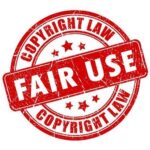Fair Use: Q&A with the Experts
 On June 9, Brandon Butler and Peter Jaszi took part in a virtual workshop for BIO on fair use for biographers. Here, Butler and Jaszi answer two follow-up questions on the topic. You can see a recording of the workshop here, and read BIO’s Statement on Best Practices regarding fair use here.
On June 9, Brandon Butler and Peter Jaszi took part in a virtual workshop for BIO on fair use for biographers. Here, Butler and Jaszi answer two follow-up questions on the topic. You can see a recording of the workshop here, and read BIO’s Statement on Best Practices regarding fair use here.
Q: Taking into account fair use doctrine, when do we—and when don’t we—have to pay licensing fees in order to use photographs and other illustrations still under copyright in our books? And how do we find out if a photograph or illustration is out of copyright and can be reprinted freely?
A: There are two key contexts in which you don’t have to pay fees to use third-party content (such as photographs or illustrative material). The first is when your use is a fair use. We covered the broad contours of the fair use doctrine, and how it applies to some recurring biographical uses, in some detail during our webinar. Another very useful source of guidance on the scope of fair use is the growing body of best practices documents developed by communities of creators and other frequent users of in-copyright works. If your use is a fair use, you don’t have to get permission or pay licensing fees. An excellent case in point, which we described during the webinar, is the Bill Graham Archives v. Dorling Kindersley case. Among other useful things, the Second Circuit’s opinion informs us that:
Preliminarily, we recognize, as the district court did, that Illustrated Trip is a biographical work documenting the 30–year history of the Grateful Dead. While there are no categories of presumptively fair use, courts have frequently afforded fair use protection to the use of copyrighted material in biographies, recognizing such works as forms of historic scholarship, criticism, and comment that require incorporation of original source material for optimum treatment of their subjects.
This important case also makes clear that fair uses don’t necessarily involve critique or commentary on the work that is being used. In that case, as in many others, the point of the reproduction was to illustrate the author’s narrative—which can be an entirely legitimate fair use purpose.
The other major context for unlicensed use is when the work you’re using is in the public domain, i.e., the work is no longer protected by copyright (or, in the case of some federal government works, it never was protected by copyright). The best quick reference for determining whether a work is in the public domain is the Cornell University Library’s handy chart. And sometimes, of course, text or images you want to use are available under a general Creative Commons license.
Q: How can we talk to our editors and publishers about a more liberal interpretation of fair use, especially in light of what you told us in the Zoom workshop about courts’ evolving and more expansive views on the law over the last 20 years?
A: Most editors and publishers need to understand four key things:
- Fair use law has changed very substantially over the last two decades, including (crucially) its treatment of unpublished material. The very bad cases regarding unpublished material in biographies that were decided in the 1980s and early 1990s were overturned by an act of Congress, which added language to the Copyright Act explicitly stating that unpublished material shall be susceptible to the same balanced analysis as published materials. More generally, the law of fair use has become much, much more coherent and much more strongly favorable toward legitimate users than it was in the 1970s and 1980s.
- This change is now very, very well established. Scholars have shown, repeatedly, that if your use is “transformative,” you will win in court. Cases about biography and related scholarly uses, in particular, show a very clear mode of analysis that any author and publisher can apply favorably to their own typical, recurring uses. Plaintiffs now understand this, and they are wary of bringing lawsuits they know will lose. Courts have become quite willing to dismiss cases at early stages when a strong fair use case is evident on the face of the complaint.
- Fair use makes books better. Arbitrary omissions and alterations that are rooted in legal fear, rather than in the author’s (and the editor’s) judgment about what best serves the story, will always make a book worse. They will lead you to leave out important context, to make assertions without important evidence, to ask the reader to trust you rather than give them the opportunity to believe their own eyes. The publisher that is willing to flex their fair use rights in support of authors will publish more, better books, and they will attract authors who value the freedom to tell their stories to the fullest extent allowed by their First Amendment rights, rather than having to trim their sails in deference to illusory legal risk. For a while, this will give savvy publishers a competitive advantage.
- According to Congress, fair use is a right, and the Supreme Court has weighed in to say that it’s closely related to the First Amendment freedom of expression. So, there is nothing sneaky or disreputable about exercising the fair use right where it applies.